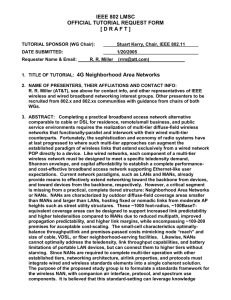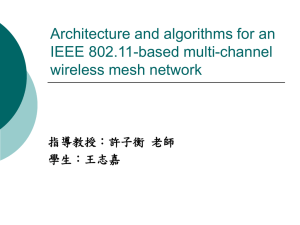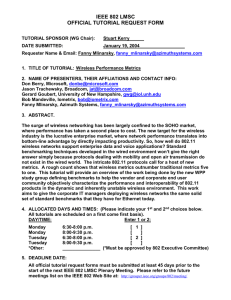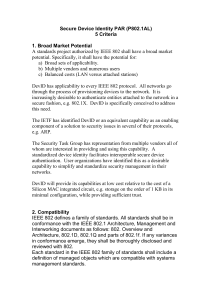IEEE 802 LAN/MAN Standards Committee Plenary Session Tutorial #1
advertisement
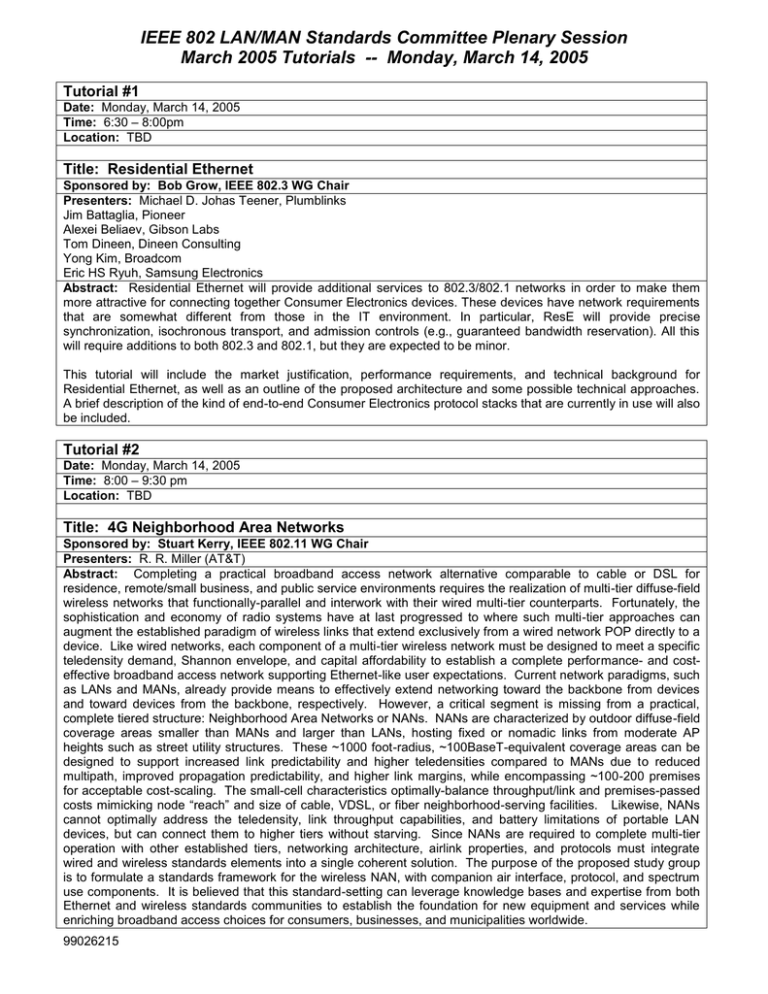
IEEE 802 LAN/MAN Standards Committee Plenary Session March 2005 Tutorials -- Monday, March 14, 2005 Tutorial #1 Date: Monday, March 14, 2005 Time: 6:30 – 8:00pm Location: TBD Title: Residential Ethernet Sponsored by: Bob Grow, IEEE 802.3 WG Chair Presenters: Michael D. Johas Teener, Plumblinks Jim Battaglia, Pioneer Alexei Beliaev, Gibson Labs Tom Dineen, Dineen Consulting Yong Kim, Broadcom Eric HS Ryuh, Samsung Electronics Abstract: Residential Ethernet will provide additional services to 802.3/802.1 networks in order to make them more attractive for connecting together Consumer Electronics devices. These devices have network requirements that are somewhat different from those in the IT environment. In particular, ResE will provide precise synchronization, isochronous transport, and admission controls (e.g., guaranteed bandwidth reservation). All this will require additions to both 802.3 and 802.1, but they are expected to be minor. This tutorial will include the market justification, performance requirements, and technical background for Residential Ethernet, as well as an outline of the proposed architecture and some possible technical approaches. A brief description of the kind of end-to-end Consumer Electronics protocol stacks that are currently in use will also be included. Tutorial #2 Date: Monday, March 14, 2005 Time: 8:00 – 9:30 pm Location: TBD Title: 4G Neighborhood Area Networks Sponsored by: Stuart Kerry, IEEE 802.11 WG Chair Presenters: R. R. Miller (AT&T) Abstract: Completing a practical broadband access network alternative comparable to cable or DSL for residence, remote/small business, and public service environments requires the realization of multi-tier diffuse-field wireless networks that functionally-parallel and interwork with their wired multi-tier counterparts. Fortunately, the sophistication and economy of radio systems have at last progressed to where such multi-tier approaches can augment the established paradigm of wireless links that extend exclusively from a wired network POP directly to a device. Like wired networks, each component of a multi-tier wireless network must be designed to meet a specific teledensity demand, Shannon envelope, and capital affordability to establish a complete performance- and costeffective broadband access network supporting Ethernet-like user expectations. Current network paradigms, such as LANs and MANs, already provide means to effectively extend networking toward the backbone from devices and toward devices from the backbone, respectively. However, a critical segment is missing from a practical, complete tiered structure: Neighborhood Area Networks or NANs. NANs are characterized by outdoor diffuse-field coverage areas smaller than MANs and larger than LANs, hosting fixed or nomadic links from moderate AP heights such as street utility structures. These ~1000 foot-radius, ~100BaseT-equivalent coverage areas can be designed to support increased link predictability and higher teledensities compared to MANs due to reduced multipath, improved propagation predictability, and higher link margins, while encompassing ~100-200 premises for acceptable cost-scaling. The small-cell characteristics optimally-balance throughput/link and premises-passed costs mimicking node “reach” and size of cable, VDSL, or fiber neighborhood-serving facilities. Likewise, NANs cannot optimally address the teledensity, link throughput capabilities, and battery limitations of portable LAN devices, but can connect them to higher tiers without starving. Since NANs are required to complete multi-tier operation with other established tiers, networking architecture, airlink properties, and protocols must integrate wired and wireless standards elements into a single coherent solution. The purpose of the proposed study group is to formulate a standards framework for the wireless NAN, with companion air interface, protocol, and spectrum use components. It is believed that this standard-setting can leverage knowledge bases and expertise from both Ethernet and wireless standards communities to establish the foundation for new equipment and services while enriching broadband access choices for consumers, businesses, and municipalities worldwide. 99026215 IEEE 802 LAN/MAN Standards Committee Plenary Session March 2005 Tutorials -- Tuesday, March 15, 2005 Tutorial #3 Date: Tuesday, March 15, 2005 Time: 6:30 - 8:00 pm Location: TBD Title: The Proposed Secure Device ID Standard for IEEE 802 Networks. Sponsored by: Tony Jeffree, IEEE 802.1, WG Chair Presenters: John Viega, CTO, Secure Software Inc. Mike Borza, CTO, Elliptic Semiconductor Inc. Abstract: The rationale and requirements for a standard Secure Device ID to be used in IEEE 802 networks are presented. Device ID (DevID) provides an unique identifier that is cryptographically bound to a device. This identifier is intended to be used during provisioning, identification and authentication operations. Provision is made for devices to possess both manufacturer and locally significant identities. DevID can provide these capabilities at low incremental cost, making it suitable for application across a broad range of network equipment and technologies. DevID and its relation to related technologies such as TPM is discussed. Tutorial #4 Date: Tuesday, March 15, 2005 Time: 8:00 - 9:30 pm Location: TBD Title: R-Bridges (Routing-enhanced Bridges) Sponsored by: Stuart Kerry, IEEE 802.11, WG Chair Presenters: Radia Perlman, Sun Microsystems Inc. Donald Eastlake 3rd, Motorola Laboratories Abstract: A design is proposed to retain the zero configuration advantage of bridges and have additional advantages: pair-wise shortest paths, minimal packet duplication in the presence of temporary loops, and allowing nodes to have multiple points of attachment with the same address. 99026215
